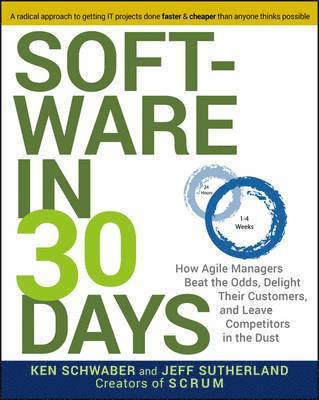
- Format
- Häftad (Paperback)
- Språk
- Engelska
- Antal sidor
- 194
- Utgivningsdatum
- 2012-05-02
- Upplaga
- 1
- Förlag
- WILEY
- Illustratör/Fotograf
- illustrations
- Illustrationer
- illustrations
- Dimensioner
- 231 x 185 x 15 mm
- Vikt
- Antal komponenter
- 1
- Komponenter
- ,
- ISBN
- 9781118206669
- 318 g
Software in 30 Days: How Agile Managers Beat the Odds, Delight Their Customers, and Leave Competitors in the Dust
- Skickas från oss inom 5-8 vardagar.
- Fri frakt över 249 kr för privatkunder i Sverige.
Passar bra ihop
De som köpt den här boken har ofta också köpt Hayek's Bastards av Quinn Slobodian (inbunden).
Köp båda 2 för 509 krKundrecensioner
Fler böcker av författarna
-
Scrum
Jeff Sutherland, J J Sutherland
-
Scrum: The Art of Doing Twice the Work in Half the Time
Jeff Sutherland, J J Sutherland
-
Agile Software Development with SCRUM
Ken Schwaber
-
Software in 30 Days
Ken Schwaber, Jeff Sutherland
Övrig information
Ken Schwaber is a cofounder of the worldwide Agile software movement and cocreator, with Jeff Sutherland, of the "Scrum" technique for building software in 30 days. He is president of Scrum.org, a software consulting firm, and led the process management product revolution of the early 1990s. Jeff Sutherland is the cocreator of Scrum, and was cosigner of the Agile Manifesto, which marked the start of the Agile movement. He has served as vice president of engineering or CTO at eleven software companies, managing the last seven entirely using Scrum, and achieved industry-leading, hyper-productive results. Jeff is the CEO of Scrum Inc., a consulting and training company.
Innehållsförteckning
About the Authors xi
Acknowledgments xiii
Introduction xv
Section I Why Every Business in the World Can Produce Software in 30 Days 1
You are probably frustrated with your software organization. You would like it to be quicker, more flexible, understand your needs better, and help you become more profitable. We look at why you are frustrated and how to fix the problem.
1 The Crisis in Software: The Wrong Process Produces the Wrong Results 3
Many software organizations follow a development process that guarantees waste, uncontrolled risk, unpredictability, surprises, and low value. We will investigate why this process was chosen, how it guarantees failure, and look and some organizations that have recovered from it.
2 Scrum: The Right Process Produces the Right Results 17
There is a process that is appropriate for software development. When you get your developers to use it, you will immediately gain productivity, quality, value, control, predictability, and satisfaction. We look at how this happens in this chapter.
3 Try It Yourself: The Pilot 33
You have read our assertion that there is a better way for you to get software developed for you. However, a lot of people have made assertions and taken a lot of your money in the past, with little or no improvement. In this chapter we show you how to prove that our approach works for no money.
4 What Can I Do? 49
You learned how to do better and you’ve tried it yourself. You like the results and you know what to tell the software organization to do. In this chapter, we look at what you can do to help what you experience in the pilot project succeed.
Section II How to Produce Software in 30 Days 55
Having better software developed for your needs is not so much hard as it is different from what you are used to. In this section, we look at a progressively beneficial set of approaches to get you from where you are now to organizational agility.
5 Getting Started with Scrum 57
Our secret sauce for improving your benefits from software is called “Scrum.” Yes, this is the rugby event that keeps the ball moving down the field. We’ll discuss Scrum, how it works, and why it works in this chapter.
6 Scrum at the Project Level 63
Most persistent improvement in software development starts at the project level. You can use Scrum to further prove its utility, or on critically important initiative that must succeed. We’ll explore what you can tell your developers to do after reading this chapter.
7 Develop a Scrum Capability 75
Success often breeds success. As more software initiatives using Scrum succeed, more people will want to get on the wagon. Rather than changing the entire organization, let’s look at how we can set up a software development universe separate from the disappointing, existing department. You can increas...
Du kanske gillar
-
Abundance
Ezra Klein, Derek Thompson
Trade Paperback


